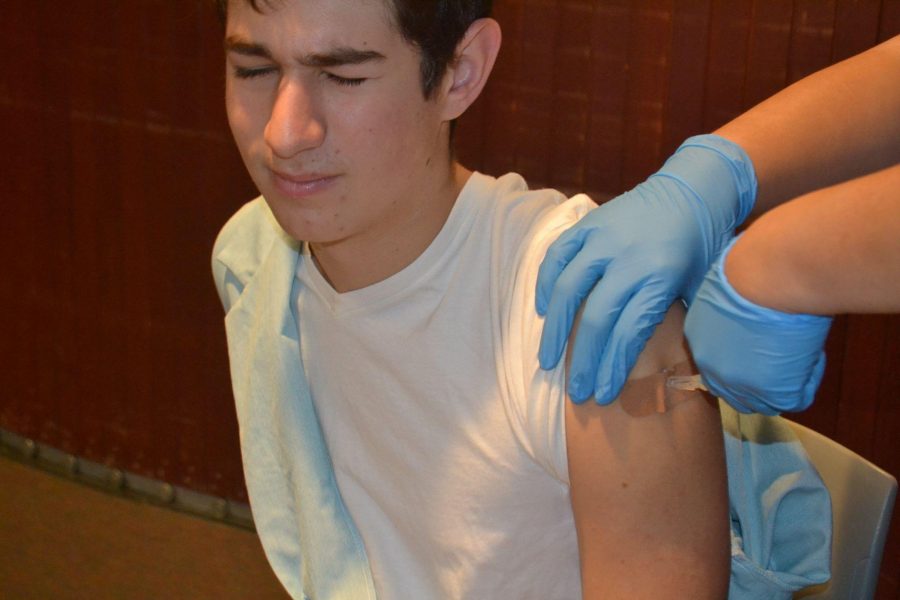Reacting to Ebola, doctors say teens should get flu shots
PREVENTION: Sophomore Jordan Levine gets a flu shot at Cedars Sinai Hospital Oct. 26. Dr. Moshe Arditi said students should protect themselves from the flu, whose symptoms could be confused with those of Ebola if an epidemic broke out here.
December 11, 2014
By Zev Kent and Hannah Jannol, Staff Writers
Ebola grabbed headlines throughout October as the usually fatal disease spread out of Africa and into the rest of the world, including the United States.
Authorities have said there is no reason for Americans to be alarmed about Ebola, and local hospitals say they are ready if a case arrives here. But there is one concrete thing they say Shalhevet students and other teenagers can do: get a flu shot.
“It’s very unlikely for a high school student to contract Ebola,” said Dr. Moshe Arditi, Executive Vice Chair of Research in the Department of Pediatrics at Cedars-Sinai Medical Center. “If they haven’t had any contact with anybody who has traveled from Liberia, they should not be concerned.”
Getting a flu shot, however would protect students not only from the flu, he said, but from fear that flu symptoms might actually be Ebola if a larger epidemic does arrive. Dr. Arditi said some initial symptoms of Ebola may be confused as symptoms of ordinary flu.
This was one of the reasons that Thomas Eric Duncan, the first Ebola patient in the U.S., was originally turned away from a hospital where he sought treatment in Dallas. His symptoms seemed flu-like and were not deemed serious enough to warrant isolation.
Now that hospitals are more aware of the similarities, avoiding the flu means not being mistaken for an Ebola patient if an outbreak occurs.
“Everyone should get a flu shot,” said Dr. Arditi. “It has nothing to do with Ebola, but it’s very important to be vaccinated from the flu.”
Dr. Zachary Rubin, Medical Director of Clinical Epidemiology and Infection Prevention at Ronald Reagan – UCLA Hospital, said all the attention to Ebola could actually improve public health in the U.S.
“The case in Dallas has caused a lot of panic,” says Dr. Rubin, “but the reality is, the likelihood of having widespread Ebola infections like they have in West Africa is pretty much zero.
“While Ebola has taken all the press, the reality is that 25,000-50,000 Americans die every year from influenza,” Dr. Rubin said.
Ebola is a virus that is carried by fruit bats, and while it does no harm to the bats, it has a 70 percent fatality rate among humans. The first person to come down with Ebola in this outbreak was a two-year-old African child whose family hunts the bats that carry the virus. Since then more than 5,000 people have died of the disease in the countries of Guinea, Sierra Leone and Liberia, according to the U.S. Centers for Disease Control, or CDC. Mr. Duncan flew on Sept.19 of this year from Liberia to Dallas, Texas, unknowingly carrying the virus with him into the United States. He was at first turned away from the hospital, then was admitted.
By the time he was hospitalized on Oct. 8, he was so ill that he could not be saved, and he died Oct. 13. In the weeks since then, patients whose symptoms have been caught earlier, including the nurses who treated Duncan, have all recovered.
Since then, the CDC and other health authorities have issued strict guidelines for hospitals and doctors, both to protect health care providers and to ensure proper diagnosis.
The guidelines include the use of full body protection suits, and being sure staff are proficient in using the suits before being able to treat a patient. Ebola is spread through bodily fluids, but even microscopic amounts of those fluids can spread the disease.
UCLA Hospital has held drills to practice receiving infected or possibly infected patients.
“We have changed the way we screen patients who come to emergency department,” said Dr. Rubin. “We have bought new isolation suits and are training staff to use them.”
Calls to Cedars-Sinai officials were not returned, but Dr. Arditi says that hospital is prepared for Ebola too.
“They followed CDC protocol and ordered protective gear,” Dr. Arditi said. “They are prepared if anyone with symptoms comes in.”
At Shalhevet, students had mixed views on whether to get a flu shot.
Freshman Tirtza Schramm and sophomore Dov Hoffman said they would get the shots, while junior J.J. Helperin said he would take nasal spray version.
Freshman David Khakshooy said he would not become immunized, believing that the shots contain dangerous chemicals.
Although teenagers’ risk of death from flu is low, preventing the flu means you’re less likely to transmit it to your grandparents or toddler siblings, cousins or friends. According to CDC figures, more than 20,000 children under age 5 are hospitalized in the U.S. each year with influenza. The greatest risk from flu is to adults over 65, who comprise the overwhelming majority of deaths from the disease.
Also, the flu can make you miserable and miss a lot of school.
Ebola, however, seems to be a much smaller threat.
“The case in Dallas has caused a lot of panic,” says Dr. Rubin, “but the reality is, the likelihood of having widespread Ebola infections like they have in West Africa is pretty much zero.”
If however, there was a case in the Shalhevet community, Dr. Aditi says it would be a bad idea to visit.
“It’s probably not best to visit them,” says Dr. Aditi. “If you must, then it’s important to wear all the protective gear.”
While preparations continue in Los Angeles, the Obama administration is trying to fight Ebola in West Africa, where it is a continuing threat. In mid-September, 3,000 troops were sent to build hospitals in the most affected countries.














